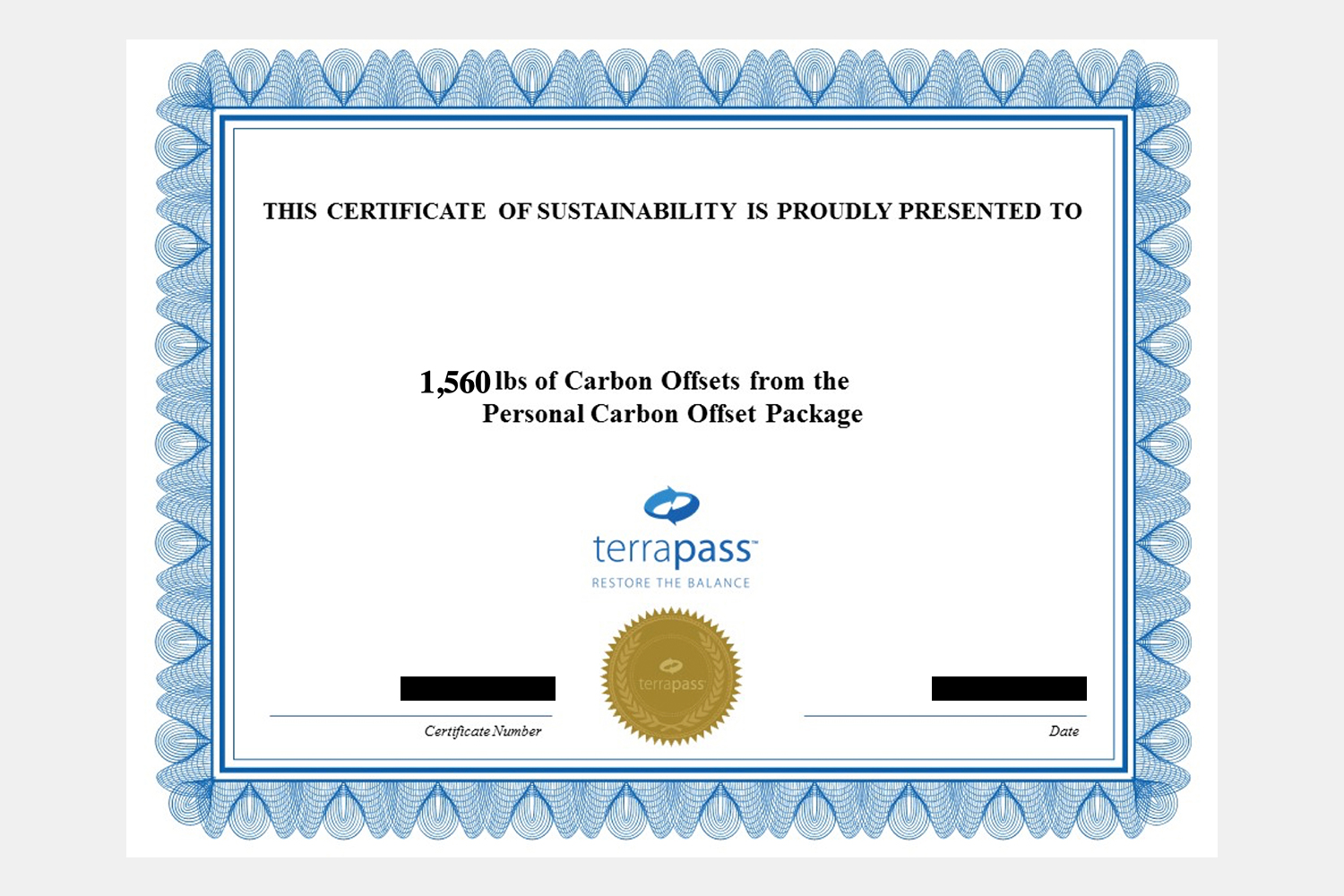
A day in the life of the average American is a day spent polluting the planet.
You wake up in a room heated by the burning of fossil fuels. Your grooming products are in single-use plastic containers. Your bacon, egg and cheese is the product of factory farming. Your car is part of the largest slice of U.S. greenhouse gas emissions. It’s a lot to reckon with — which is why most people try not to.
But what if there were a Get Out of Jail Free card? A Catholic indulgence for the climate crisis? A way for individuals to simply and easily counteract the greenhouse gases for which they’re responsible?
Enter carbon offsets. In their most basic sense, carbon offsets are projects you can fund that will theoretically reduce greenhouse gas emissions, and thus theoretically balance out your personal pollution. And while you could potentially tally up your total carbon emissions for a year — or 10 years, or a lifetime — and buy carbon offsets for it all, there is a specific area of life where this concept is starting to take off: air travel.
Most people understand that we’re in the middle of a climate crisis and need to massively reduce greenhouse gas emissions around the globe, and fast. What they don’t understand is how to make meaningful changes in their daily lives that will actually contribute to that goal — like, say, flying less.
Here’s the cold, hard truth: if you fly more than once a year, and especially if any of the flights you take are international, you are causing an inordinate amount of greenhouse gas pollution. For perspective, according to the website Shame Plane, if you travel round-trip from Los Angeles to Paris in economy just once, you will emit more greenhouse gases than one person is allowed per year if we want to meet the Paris Agreement targets for climate-change reduction. Not only that, but even if you went vegetarian, only ate local food, cut out food waste, recycled, only used LED light bulbs, always used a reusable shopping bag and never drove a car, you still wouldn’t counteract the carbon emissions from that one single international flight. And if you switched that ticket from economy to business or first class? Forget about it.

The name of that website, Shame Plane, is a riff on “flight shame,” an anti-flying movement that began in Sweden (where it is called flygskam) to raise awareness about the carbon emissions from air travel. If you’ve never heard of it, you’re probably at least aware of climate activists like Greta Thunberg who are promoting the same ideas; the 16-year-old Time Person of the Year swore off flying, and backed it up by traveling across the Atlantic Ocean not by plane, but by sailboat — twice.
Chances are you won’t ever sail across an entire ocean (and probably don’t have a massive social-media following that could connect you with experienced sailors, anyway), and you’re probably not going to stop flying altogether, either. So carbon offsets start to sound like a pretty slick solution to airplane emissions, which are slowly being seen for what they are: a crucial piece of the climate-change puzzle.
But what, exactly, are these greenhouse gas-reducing projects promised by carbon offsets? How does one buy them and know they’re actually doing what they say? And most importantly, should you buy them at all?
What are carbon offsets?
The projects you help fund to balance out your own carbon emissions can vary widely. Depending on the marketplace where you buy them, carbon offsets can come in the form of renewable energy (such as wind or solar farms), carbon sequestration (such as protecting or creating forested areas that will suck down CO2) or greater energy efficiency (such as cleaner cookstoves in developing countries).
Thus, prices for balancing out your emissions can depend on how much a project costs, as well as the effectiveness of a project. But even more than that, different organizations treat the impact of carbon emissions differently. In other words, we’re still in the Wild West phase of establishing standards and regulations.
Don’t let that deter you, though. Reputable carbon-offset programs will either have a certificate of oversight or some other third-party verification. This auditing process not only proves the money is going to the designated project, but that the carbon offsets are enforceable, permanent and additional (that is, they wouldn’t have taken place without your financial assistance), which the nonprofit Natural Resources Defense Council points to as necessary.
Three such programs include The Gold Standard, Green-e and Cool Effect. But even within these certified organizations there are differences: The Gold Standard is chiefly concerned with verifying projects around the globe, so you might see their certification on other carbon offsets, but you can also buy individual offsets directly through their website. Green-e is another global third-party certifier, but it links out to projects that it has verified instead of selling directly. Cool Effect, meanwhile, offers a streamlined platform for frequent flyers to easily calculate and offset their air travel.
How do you buy carbon offsets?
This is a question I asked myself not long ago. This fall and winter, I took two technically unnecessary trips by plane: a one-way from Minneapolis to Denver, and a roundtrip from Minneapolis to New York City. There are various calculators online with the express purpose of determining air travel emissions, which will normally be spit out in metric tons, one of the best of which is from the International Civil Aviation Organization.
But if people are going to voluntarily buy carbon offsets, it has to be easy. That’s something San Francisco Airport learned back in 2009 when it set up “climate kiosks” where flyers could buy carbon offsets at the airport (yes, these have been around for a while). It didn’t catch on, because as we’ve outlined here, it’s a hard process to grasp.
For ease, I decided to go with Terrapass, which is on Green-e’s list of certified marketplaces. They have a user-friendly carbon footprint calculator for individuals as well as businesses and events. What makes it ideal for flying, though, is that you can choose the specific airports you’re flying to and from, and also add multiple flights.
For my one-way Denver flight, it calculated 233 lbs. of carbon dioxide equivalent (or CO2e), and for my round-trip New York flight, it calculated 1,326 lbs. Total damage: 1,560 lbs. of CO2e. That sounds like a lot, and on the personal pollution scale, it is. But how much money does Terrapass say I have to pay to offset that? Just $7.78.
I clicked “Buy Offsets,” put in my credit card info, then placed the order. A screen popped up: “Congratulations! You have reduced your climate impact. Let your friends know!” It even presented me with a printable certificate akin to a diploma telling me what a responsible citizen I’d been (which I didn’t actually print, because paper waste).

Should you buy carbon offsets?
In November, Lufthansa CEO Carsten Spohr channeled Donald Trump at an aviation conference, stating that “Airlines should not have to be seen as a symbol of climate change. That’s just fake news,” as reported by aviation blog Simple Flying. He went on to say, “Our industry contributes 2.8% of global CO2 emissions. As I’ve asked before, how about the other 97.2%?”
He’s correct that at this moment in time, in the grand scheme of things, air travel is not directly one of the biggest contributors to the climate crisis (although as Elizabeth Kolbert pointed out in her Pulitzer Prize-winning book The Sixth Extinction, air travel has a much larger indirect effect, but that’s another story). The bigger problem is that at a moment where a drastic reduction in carbon emissions is absolutely necessary, projections for the popularity of air travel foretell a dramatic increase in the coming years. According to Bloomberg, the aviation industry is “on track to become the single biggest emitter of carbon dioxide within three decades if the predicted cuts in other sectors materialize, data and projections from UN agencies show.” Flying has slowly become more and more accessible, and in the coming decades we’re looking at a global boom at the exact moment that as we should be cutting out all unnecessary flights, climatologically speaking.
Take all those factors into consideration, and it’s easy to end up in a place of inaction, which has become a common theme on all fronts where climate change is concerned. The problem simply seems too big. The leaders in environmental action say carbon offsets aren’t a solution, even though most people are only just learning about them. Frequent flyers look around at others and see them traveling with impunity, so why should they (or you) take the time to care?
Instead of letting all those issues overwhelm you, consider this quote from Seth Wynes, a climate change researcher at the University of British Columbia in Vancouver, in The Washington Post: “It’s easy on a global level to say, ‘Okay, air travel is only a small portion of global emissions depending on how you look at it, and therefore it’s not a giant contributor.’ But if you do fly, then each flight that you take is likely to be a large chunk of your personal carbon footprint in a year.”
Sometimes you can only be responsible for yourself, and in all things in life, that’s a good place to start making change. Sure, $7.78 isn’t going to significantly reduce the carbon emissions crisscrossing our country from 44,000 flights every single day, but actively engaging with the pollution from your business trips, vacations and flights home for Christmas will make you more aware of the effects of your other life choices, and in turn raise awareness among the people in your circle of influence, which will hopefully lead to something even bigger.
Related: Can High-Speed Trains Solve America’s Transit Crisis?
Subscribe here for our weekly travel newsletter, The Journey.
This article appeared in an InsideHook newsletter. Sign up for free to get more on travel, wellness, style, drinking, and culture.

























